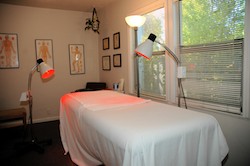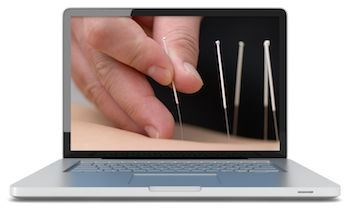Acupuncture Practice Management
We covered acupuncture CPT billing codes and ICD-9 & ICD-10 diagnosis codes in our prior blog article on acupuncture insurance billing. To learn more about day-to-day acupuncturist insurance billing issues, visit the Acupuncture Billing blog page. Today, we’ll take a look at a few other issues that impact the career of a licensed acupuncturist including special billing requirements, practice management, community outreach and passive income.
We have received many questions regarding how to legally bill general insurance, auto/PI insurance and worker’s compensation insurance. This gets a little tricky when someone has two complaints and each individual complaint is covered by a different type of insurance. Remember, the following is a general national guideline but state laws vary.
Perhaps the easiest way to go over this issue is by example. John Doe enters the office with neck pain and lower back pain. He developed neck pain over the years but the lower back pain is part of an accepted worker’s compensation claim. In many states, an acupuncturist cannot accept cash for the worker’s compensation related lower back pain and must bill the worker’s compensation insurance carrier unless there is a written denial by the carrier.
Keep separate chart notes for John Doe with separate computer entries for billing. One is worker’s compensation and the other is general insurance. One has the lower back pain ICD diagnosis code and the other has the neck pain code. Carefully document the patient intake in each chart relevant to each complaint and log the acupuncture points used.  Application of GB20 to GB21 with electroacupuncture for neck pain is logged in one chart and electroacupuncture from K3 to K3 for lower back pain in another. These are just quick examples of treatment strategies. Please take a look at many of our other HealthCMi acupuncture continuing education courses and articles on local acupuncture points, distal points, scalp points, auricular points and others for many ways to treat neck and back pain.
Application of GB20 to GB21 with electroacupuncture for neck pain is logged in one chart and electroacupuncture from K3 to K3 for lower back pain in another. These are just quick examples of treatment strategies. Please take a look at many of our other HealthCMi acupuncture continuing education courses and articles on local acupuncture points, distal points, scalp points, auricular points and others for many ways to treat neck and back pain.
Now that each chart is separate and the needle applications/procedures are carefully documented for each condition, you have met the legal standard for most states. Simply bill each carrier accordingly. You may also choose to bill only one carrier. However, if you do not bill for the other body part you may inadvertently contribute to closing the patient’s health care claim due to non-treatment. The carrier will have no record of treatment and will assume that the case is inactive.
There are many issues affecting the income of a licensed acupuncturist. Let’s start by looking at the new federal health care law. Next, we’ll take a look at the impact of onerous in-network systems on our financial and emotional well-being. Finally, let’s get into the long-term financial structures of our acupuncturist practices and how to create a prosperous career and potential for retirement income. We will compare passive income benefits with fee for service issues.
Recent Developments
Several states now require acupuncture insurance coverage for all individual and small group health insurance plans. This includes Maryland and California. The PPACA (Patient Protection and Affordable Care Act), also known as Obamacare, mandates basic standards for health insurance. As such, preventative medicine is now legally part of the basic standard required of individual and small group health insurance plans.
As part of the PPACA implementation, the US Department of Health and Human Services directed each state to determine the exact meaning of preventative care by law. Some states define acupuncture into this umbrella. For example, the California legislature adopted a Kaiser Permanente plan as a basic standard. Essentially, all health insurance plans must provide at the very least the amount of care provided in the selected Kaiser Permanente plan. The plan includes acupuncture and therefore the state now requires its inclusion in health insurance plans. This applies to small group and individual plans. Large group and self-insured plans are completely unaffected in 2014.
The PPACA does not directly impact issues such as co-pays and deductibles. However, the new federal law sets limits on cost sharing and actuarial value. As a result, regulations may emerge that impact out of pocket expenses both on a state and federal level. For now, expect issues such as in-network requirements, co-pays, deductibles, limitations on specific types of diagnoses, medical necessity review panels and the like to remain.
Many financial obstacles to patient care remain legal. For example, one major insurance company applies only $25 per office visit towards the deductible. Another enormous insurance company only allows four diagnoses: neck pain, back pain, nausea due to chemotherapy, nausea due to pregnancy. If your patient has leg pain or another disorder other than those four diagnoses, the insurance company will not provide coverage. It is important that this does not cause communication issues between you and your patient. Let them know the limitations of their insurance coverage as soon as possible.
Upcoming Changes
We didn’t know what to expect. However, the first few plans affected by the PPACA have trickled into our office setting. One major plan has no in-network requirements, no overt diagnosis limitations, no deductibles and requires a $60 co-pay per visit. At the very least, it appears that the plan is upfront about exactly what type of reimbursement can be expected. We will be watching to see if there are caps on the total amount of reimbursement per office visit. So far, that issue has been all over the map. Literally, in every state there are vast differences from policy to policy.
We have seen plans that cap acupuncture insurance reimbursements to $5 per visit and others that pay over $150 per visit. This is true using the same billing structure: an initial 15 minute 97813 electroacupuncture CPT code billed at $75 in combination with an additional 15 minute 97814 code billed at $25. Sometimes the addition of another 97814 makes no difference whatsoever and sometimes it is paid in full.
Networks
Be careful. Some networks cap acupuncture insurance benefits to $40 per visit and require significant amounts of paperwork. Remember to enjoy your practice. If the paperwork makes you miserable, it just isn’t worth it. Time and again, I have met with acupuncturists that have felt the abusive impact of the discriminatory elements built into some HMO and network bureaucracies.
These restrictions are often inflicted by third party administrative companies that handle claims for an even larger insurance company. Denials and non-payment for services rendered are all too common and make acupuncturists unhappy. If you find that you are not looking forward to treating someone because of the paperwork, faxes and phone calls necessary to get paid, perhaps it is time to drop the offending network restriction.
If your state allows dual fee schedules based on underinsurance and income inequality issues, consider a discounted cash price over network involvement. On the other hand, some networks have the opposite effect. They pay more, require little to no paperwork and are timely with reimbursement. I am always pleasantly surprised to find insurance companies that are reputable. It may be best to stick with the companies that are fair and moral and dump the rest. As professionals, we do not want to support industries that engage in skimming and unethical behavior.
Career
Open air seated treatment facilities with simultaneous patient treatments, mobile clinics, individual room treatments and other types of treatment facilities are part of a fee for service financial structure. This is a trade of time for money and has inherent limitations. An interesting exception is emerging. For some doctors, patients pay an annual fee for membership in their practice. We see this new model emerging in physician settings. Thinking about this arrangement? Please be sure to check your state’s laws and regulations. The best place to start is with your state acupuncture board.
Another variance on the fee for service structure is billing per issue and not by office visit.  In some states, this one-time payment must be held in an escrow account bearing interest that is paid to the patient. Again, if you are thinking of this financial structure, it is best to check with your state acupuncture board. Often, you can request a legal opinion. It is also good to check with your malpractice insurance carrier any time you vary from the classic fee per office visit structure. They can often provide a legal opinion.
In some states, this one-time payment must be held in an escrow account bearing interest that is paid to the patient. Again, if you are thinking of this financial structure, it is best to check with your state acupuncture board. Often, you can request a legal opinion. It is also good to check with your malpractice insurance carrier any time you vary from the classic fee per office visit structure. They can often provide a legal opinion.
Many acupuncturists think of their career in terms of number of patients per week, monthly overhead and rates billed per visit. This involves thinking about shared office spaces, billing software, different types of billing and rates, advertising, community outreach to promote awareness and other ways to support this model of care. A small number of acupuncturists receive a salary or additional fee for service compensation by working at an HMO or medical facility. In all cases, time is traded for money. The pitfalls in this structure are fatigue, aging, financial vulnerability in cases of debilitation or illness and persistent overhead during time off from work. Nonetheless, many acupuncturists have prosperous careers based solely on seeing patients in an office setting.
Let’s look at the numbers for the fee for service model and then get into some non-fee for service income structures. If an acupuncturist sees 60 patients per week at $85 per visit, this yields a gross income of $244,800.00 per year based on 48 work weeks. At 40 patients per week, this drops to $163,200.00 per year. Next, overhead and taxes reduce income significantly. Often, net income is about half of unadjusted gross income.
Acupuncturists with incomes at these levels may want to consult with their accountants about incorporating as an S-Corporation or LLC. Medical professionals tend to use the S-Corp structure. This can help to reduce schedule C taxes. Under an S-corp, books will need to be kept up-to-date, accounting fees are higher but taxes are lower. Incorporating is not always a good idea if one’s income is less than $45,000.00 per year. The tax savings may not justify the accounting and bookkeeping expenses. Once a medical professional hits the $70,000.00 per year mark or above, it is best to consult with your accountant on the corporate structure issue.
Fee for Service Gross Income
Based on 48 work weeks per year
80 patients per week, $125 per visit, $480,000
60 patients per week, $125 per visit, $360,000
40 patients per week, $125 per visit, $240,000
30 patients per week, $125 per visit, $180,000
20 patients per week, $125 per visit, $120,000
80 patients per week, $85 per visit, $326,400
60 patients per week, $85 per visit, $244,800
40 patients per week, $85 per visit, $163,200
30 patients per week, $85 per visit, $122,400
20 patients per week, $85 per visit, $81,600
80 patients per week, $60 per visit, $230,400
60 patients per week, $60 per visit, $172,800
40 patients per week, $60 per visit, $115,200
30 patients per week, $60 per visit, $86,400
20 patients per week, $60 per visit, $57,600
Getting Creative
Many acupuncturists have additional income as teachers and professors. Others work at herbal medicine, nutritional and acupuncture supply companies as professional consultants and researchers. Some of these jobs offer substantial salaries or contract work with benefits. Acupuncturists often publish and generate passive income from royalty income. At HealthCMi, our authors often receive ongoing royalty payments for acupuncture continuing education courses created for acupuncture CEU and PDA credit. Publishing helps acupuncturists to contribute to the health and welfare of both the general community and the professional community. This type of work is on purpose and provides and opportunity to learn and grow.
Some acupuncturists use treatment modalities outside of textbook scope of practice definitions as outlined by state laws and regulations. This can be problematic from a legal perspective. Make sure that whatever medical advice or treatment modalities are used in the clinical setting are within your scope of practice. For example, in some states, acupuncturists may not bill for the application of ultrasound, laser acupuncture or magnet therapy. In some states, these modalities are prohibited entirely.
Acupuncturists may also engage in MLM (multi-level marketing). This usually involves selling a product or product line wherein one is encouraged to sign-up a sales force from which a percentage can be drawn from their sales. The up-line gets a percentage of your sales and you receive a percentage from the down-line. In many cases, this type of practice is legal and in other cases this may violate scope of practice laws and regulations. Please check with your state board and malpractice insurance company on the specifics of MLM endeavors. The focus and legal parameters of a licensed acupuncturist is to determine a differential diagnosis and to provide treatment within the scope of practice. It is important that any MLM product distribution meets scope of practice requirements.
A great inclusion of additional work within one’s scope of practice is to teach Tai Qi or Qi Gong. Other forms of community involvement are dietetics counseling, visits to detox centers to provide treatments and house calls. All provide important contributions to society and engage the acupuncturist in his or her local community. On a larger scale, acupuncturists may take their teaching on the road and lecture or provide workshops nationally or internationally.  Sometimes acupuncturists have radio shows and make video releases to educate consumers and acupuncturists in the field of Traditional Chinese Medicine (TCM) and other forms of Traditional Medicine such as Traditional Japanese Medicine and Traditional Korean Medicine.
Sometimes acupuncturists have radio shows and make video releases to educate consumers and acupuncturists in the field of Traditional Chinese Medicine (TCM) and other forms of Traditional Medicine such as Traditional Japanese Medicine and Traditional Korean Medicine.
Teaching classes, lecturing and providing workshops expands the fee for service structure from a one-on-one setup to a broader scope. This can be enriching on a personal level by engaging a larger audience. Financially, this provides additional income and can highlight one’s publications, herbal products and more.
A profitable setup is to buy a building and lease the rooms to other practitioners. Initially, this may be risky but the long-term benefits may have a strong upside. First, one has the ability to control their dreams. The physical office layout and managerial structure is up to you. You have the ability to choose what types of practitioners will be included in the office setting and ultimately what variety of services patients can expect in your office setting. This requires a time investment and one must be comfortable with hiring and firing employees.
As an owner, one may be able to practice with minimal overhead if the rents are large enough to cover most expenses. This includes office supplies, salaries, utilities, mortgage, etc. The same structure can be set-up under a lease scenario wherein one is the primary lease holder. However, an owner has the ability to sell the property for a profit or loss, has greater control over the space and may be able to pay the building off thereby minimizing long-term overhead.
In a perfect world, the tenants provide professional referrals and cover the cost of owning and maintaining the building and the practices. In the real world, owning a building is an investment and may take time before profits are realized. This is a real estate business scenario and one key factor is to have enough financial reserves to weather temporary financial setbacks. One must be able to handle a sudden loss of tenants and subsequent income loss until new tenants can be found. It takes a bit of time, risk and effort but there are numerous tax benefits and rewards to owning the building and property. This approach extends far beyond the fee for service scenario and may wind up generating passive income and equity.
The home practice is also an interesting set-up for an acupuncturist. Many choose a simple granny unit setup or have more elaborate treatment facilities. This approach reduces overhead and has modest tax benefits. When buying a personal home, one may want to consider a nice Tai Qi studio or acupuncture treatment facility as part of the purchase. This comes down to issues of zoning, parking, public transportation and space.
The ultimate goal is to enjoy one’s prosperity. There are many ways to enjoy being an acupuncturist. Some hear the calling of the road and travel to remote villages to provide healthcare while others work on cruise ships. There are many ways to contribute to society with the skills of a licensed acupuncturist. It is important to find the way that is right for you.



